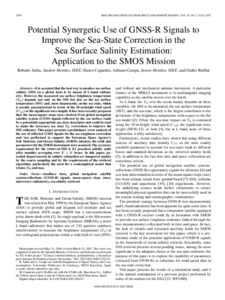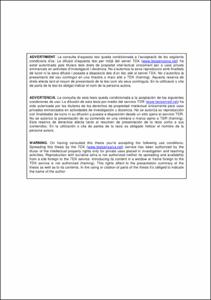Exploració per autor "Sabia, Roberto"
Ara es mostren els items 5-11 de 11
-
Potential synergetic use of GNSS-R signals to improve the sea-state correction in the sea surface salinity estimation: Application to the SMOS mission

Sabia, Roberto; Caparrini, M.; Camps Carmona, Adriano José; Ruffini, G. (IEEE-INST ELECTRICAL ELECTRONICS ENGINEERS INC, 2007-07-31)
Sabia, Roberto; Caparrini, M.; Camps Carmona, Adriano José; Ruffini, G. (IEEE-INST ELECTRICAL ELECTRONICS ENGINEERS INC, 2007-07-31)
Article
Accés obert -
Potential synergetic use of GNSS-R signals to improve the sea-state correction in the sea surface salinity estimation: Application to the SMOS mission

Sabia, Roberto; Caparrini, M.; Camps Carmona, Adriano José; Ruffini, G. (IEEE Press. Institute of Electrical and Electronics Engineers, 2007-07)
Sabia, Roberto; Caparrini, M.; Camps Carmona, Adriano José; Ruffini, G. (IEEE Press. Institute of Electrical and Electronics Engineers, 2007-07)
Presentació
Accés obertIt is accepted that the best way to monitor sea surface salinity (SSS) on a global basis is by means of L-band radiometry. However, the measured sea surface brightness temperature (TB) depends not only on the SSS but ... -
Sea surface salinity retrieval error budget within the esa soil moisture and ocean salinity mission

Sabia, Roberto (Universitat Politècnica de Catalunya, 2008-10-13)
Sabia, Roberto (Universitat Politècnica de Catalunya, 2008-10-13)
Tesi
Accés obertL’oceanografia per satèl•lit ha esdevingut una integració consolidada de les tècniques convencionals de monitorització in situ dels oceans. Un coneixement precís dels processos oceanogràfics i de la seva interacció és ... -
SMOS REFLEX 2003: L-Band Emissivity Characterization of Vineyards

Vall-Llossera Ferran, Mercedes Magdalena; Camps Carmona, Adriano José; Corbella Sanahuja, Ignasi; Torres Torres, Francisco; Duffo Ubeda, Núria; Monerris Belda, Alessandra; Sabia, Roberto; Selva Valero, Daniel; Antolín, Carmen; López Baeza, Ernesto; Ferrer, Joan Ferran; Saleh, Kauzar (IEEE-INST ELECTRICAL ELECTRONICS ENGINEERS INC, 2005-05-31)
Vall-Llossera Ferran, Mercedes Magdalena; Camps Carmona, Adriano José; Corbella Sanahuja, Ignasi; Torres Torres, Francisco; Duffo Ubeda, Núria; Monerris Belda, Alessandra; Sabia, Roberto; Selva Valero, Daniel; Antolín, Carmen; López Baeza, Ernesto; Ferrer, Joan Ferran; Saleh, Kauzar (IEEE-INST ELECTRICAL ELECTRONICS ENGINEERS INC, 2005-05-31)
Article
Accés obertThe goal of the Soil Moisture and Ocean Salinity mission over land is to infer surface soil moisture from multiangular L-band radiometric measurements. As the canopy affects the microwave emission of land, it is necessary ... -
SMOS REFLEX 2003: L-band emissivity characterization of vineyards

Vall-Llossera Ferran, Mercedes Magdalena; Camps Carmona, Adriano José; Corbella Sanahuja, Ignasi; Torres Torres, Francisco; Duffo Ubeda, Núria; Monerris Belda, Alessandra; Sabia, Roberto; Selva Valero, Daniel; Antolín, Carmen; López Baeza, Ernesto; Ferrer, Joan Ferran; Saleh, Kauzar (IEEE-INST ELECTRICAL ELECTRONICS ENGINEERS INC, 2005-05-31)
Vall-Llossera Ferran, Mercedes Magdalena; Camps Carmona, Adriano José; Corbella Sanahuja, Ignasi; Torres Torres, Francisco; Duffo Ubeda, Núria; Monerris Belda, Alessandra; Sabia, Roberto; Selva Valero, Daniel; Antolín, Carmen; López Baeza, Ernesto; Ferrer, Joan Ferran; Saleh, Kauzar (IEEE-INST ELECTRICAL ELECTRONICS ENGINEERS INC, 2005-05-31)
Article
Accés obertThe goal of the Soil Moisture and Ocean Salinity mission over land is to infer surface soil moisture from multiangular L-band radiometric measurements. As the canopy affects the microwave emission of land, it is necessary ... -
The Emissivity Of Foam-Covered Water Surface At L-Band: Theoretical Modeling And Experimental Results From The FROG 2003 Field Experiment

Camps Carmona, Adriano José; Vall-Llossera Ferran, Mercedes Magdalena; Villarino Villarino, Ramón; Reul, Nicolas; Chapron, Bertrand; Corbella Sanahuja, Ignasi; Duffo Ubeda, Núria; Torres Torres, Francisco; Miranda Mendoza, Jorge José; Sabia, Roberto; Monerris Belda, Alessandra; Rodríguez Sánchez, Rubén (IEEE-INST ELECTRICAL ELECTRONICS ENGINEERS INC, 2005-05-31)
Camps Carmona, Adriano José; Vall-Llossera Ferran, Mercedes Magdalena; Villarino Villarino, Ramón; Reul, Nicolas; Chapron, Bertrand; Corbella Sanahuja, Ignasi; Duffo Ubeda, Núria; Torres Torres, Francisco; Miranda Mendoza, Jorge José; Sabia, Roberto; Monerris Belda, Alessandra; Rodríguez Sánchez, Rubén (IEEE-INST ELECTRICAL ELECTRONICS ENGINEERS INC, 2005-05-31)
Article
Accés obertSea surface salinity can be measured by microwave radiometry at L-band (1400-1427 MHz). This frequency is a compromise between sensitivity to the salinity, small atmospheric perturbation, and reasonable pixel resolution. ... -
The emissivity of foam-covered water surface at L-band: theoretical modeling and experimental results from the FROG 2003 field experiment

Rodríguez, R; Monerris Belda, Alessandra; Sabia, Roberto; Miranda Mendoza, Jorge José; Camps Carmona, Adriano José; Vall-Llossera Ferran, Mercedes Magdalena; Villarino Villarino, Ramón; Reul, N; Chapron, B; Corbella Sanahuja, Ignasi; Duffo Ubeda, Núria; Torres Torres, Francisco (IEEE Press. Institute of Electrical and Electronics Engineers, 2005-05)
Rodríguez, R; Monerris Belda, Alessandra; Sabia, Roberto; Miranda Mendoza, Jorge José; Camps Carmona, Adriano José; Vall-Llossera Ferran, Mercedes Magdalena; Villarino Villarino, Ramón; Reul, N; Chapron, B; Corbella Sanahuja, Ignasi; Duffo Ubeda, Núria; Torres Torres, Francisco (IEEE Press. Institute of Electrical and Electronics Engineers, 2005-05)
Article
Accés obertSea surface salinity can be measured by microwave radiometry at L-band (1400–1427 MHz). This frequency is a compromise between sensitivity to the salinity, small atmospheric perturbation, and reasonable pixel resolution. ...








